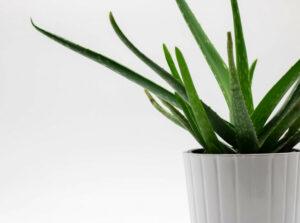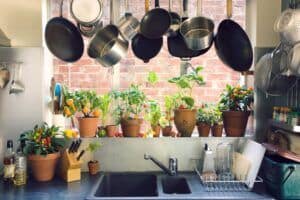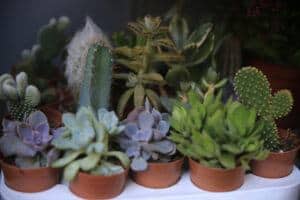HousePlantJoy is supported by our audience. When you purchase through one of our links, we may earn a small affiliate commission. As an Amazon Associate I earn from qualifying purchases. Your cost is not affected.
==================
Ever noticed how our kitchens often lack a touch of greenery? Well, let’s change that! The idea of plants in the kitchen might sound unconventional, but trust me, it’s a game-changer. Picture this: fresh herbs at arm’s reach for your favorite recipes, aloe vera ready to rescue your fingertips from kitchen mishaps, and vibrant blooms adding a pop of color to your cooking haven. In this guide, we’re about to shake up the sterile kitchen look and introduce you to a lively bunch of kitchen-friendly plants. From the culinary wonders of herbs to the air-purifying prowess of the spider plant, we’ve got the lowdown on the best plants to turn your kitchen into a green oasis. Let’s bring some life into your cooking space, shall we?
Our best plants for the kitchen list might surprise many people. In fact, the kitchen often lacks any living greenery. But these plants may convince you to step out from the sterile kitchen look and create a green space that calls you in to cook even more.
Keeping plants in the kitchen makes sense in several ways. Some plants, like culinary herbs, find their way into your favorite dishes. Others such as the valued aloe plant stand aside until needed to soothe a burn or cut. Of course, some plants simply provide a needed decorative style to your cooking space.
Why do we seem to forget bringing these living wonders into the kitchen? It doesn’t seem logical, when you think about it. In the kitchen, our plants live close to the sink, making watering easier. Many kitchens have ample sunlight to keep the greenery healthy and happy. And because the kitchen is so central to our everyday lives, you will notice when they need a drink or even a little trim. When you think about it, the kitchen may be the perfect place to keep plants.
Aloe Vera
Aloe Vera
Aloe vera plants possess a comforting appeal in appearance, as well as purpose. The long, green leaves host spiked edges. Inside, a gooey gel awaits.
Aloe vera plants offer some health benefits when eaten or included in beverages. Add them to your smoothies or other drinks. Read here to see how to prepare your aloe for eating or drinking.
However, the aloe vera plant’s best-known purpose remains that of comforting and healing. Used for many generations as a medicinal gel, the inside of the aloe leaf provides soothing relief to burns and cuts.
Studies prove that aloe vera gel does heal wounds and also increases the flexibility and strength of the skin. It also relieves sunburn and minor burns and scrapes that happen outside the kitchen.
Aloe vera is an easy-to-keep plant that needs well-drained soil and infrequent to moderate watering, depending on the humidity level of the air. It shows a strong preference for warmer air, which makes the kitchen ideal.
Herbs
Most herbs kept in the kitchen are small to medium-sized plants that find their way into cooking and baking. Some flavor our tea or smoothies, too.
Consider keeping some popular plants like basil, mint, oregano, thyme, sage, cilantro, rosemary, and parsley. Most of the culinary herbs do well on your windowsill or shelf with indirect lighting. They require moderate watering and a bit of trimming if you have not needed their flavorings frequently.
Because they are usually kept in small pots or decorative mini gardens. Hanging planters work well, too. Keeping them nearby ensures you can use them when needed.
Spider Plant
Spider Plant
While not edible, the spider plant provides another great purpose in your home- it helps clean the air of toxins. The long green leaves carry a white stripe down the middle. However, the Reverse Varigated variety sports white edges with a green stripe in the mid-section of each. They grow in bunches of blade-shaped leaves. Interestingly, they propagate by spawning baby spider plants off the runners.
Spider plants thrive in higher humidity with plenty of indirect sunlight. Keeping your spider plant in the kitchen makes it easier to keep it misted and watered.
These plants, while not edible, are not toxic to your pets or people. So if kitty happens to nibble on one, she will not be harmed.
African Violet
African Violet
Colorful flowers amidst round, fuzzy green leaves make the African Violet plant quite attractive in any room. The small blooms of purple, blue, pink, or white bring a splash of color to your kitchen.
These plants love plenty of light and while they need moderate watering, they are sensitive to too much or too little. Water before they dry completely but ensure the pot allows proper draining.
The African Violet is another plant that is non-toxic. While most pets don’t bother them, if they do, they will not be harmed. Keep them on a shelf or window sill and enjoy their beauty year-round.
Air Plant
As the name implies, the air plant literally grows in the air. It’s true, no soil or pot needed for this little plant. It sports tufts of green pointed leaves.
In the kitchen, air plants gracefully perch from interesting hangers or happily rest on rocks on your counter or sill. You may find them the easiest plant to care for. Provide good lighting and mist often with water. Occasionally, dunk them completely in water to keep them happiest.
Pothos
Golden pothos or Epipremnum aureum
Need a plant for a lower-light kitchen? The Pothos might solve your need. These plants prefer less light and need only occasional watering. They are truly easy-to-care-for plants.
But while they need little care, they provide great beauty. The long, green vines host gorgeous heart-shaped leaves. On a shelf or in a hanging basket, the Pothos makes a nice addition to any room, including your kitchen.
Peace Lily
Like the Spider Plant, the Peace Lily is known to be quite good at purifying the air. And like the Pothos, they prefer a lower lighting area.
But while they beautify your home with white flowers amidst shiny green leaves, these elegant plants are not pet-friendly. In fact, they are quite toxic. For safest care, place them away from curious pets and small children.
Rubber Plant
Rubber Plant, Ficus
Choose a corner of your kitchen across from a sunny window for the Rubber Plant as they need bright, but indirect light. Provide a soil that drains well and is well-aerated. Given those easy instructions, the Rubber Plant keeps happy with minimal care.
Of course, the Rubber Plant provides a focal showpiece in any room And your kitchen is no exception. The thin, upright trunk sports shiny, dark green leaves. However, be sure to keep the leaves dusted on a regular basis to enjoy their shiny beauty.
Snake Plant
Snake Plant
You might prefer the other names for the Snake Plant. These include I Saint George’s sword, mother-in-law’s tongue, and viper’s bowstring hemp, among other names. By any name, these succulent plants grow tall. However, they don’t spread wide, making them ideal for counter spaces.
These lower maintenance plants need only indirect light and a pot that provides good drainage. Avoid over-watering. In fact, they tolerate drier soil quite well.
In truth, the Snake Plant shows as less than glamorous. However, what it lacks in striking beauty, it makes up for. Truthfully, this plant is a workhorse at purifying the air. In fact, it’s known to be among the best air cleaners among houseplants.
Fern
Boston Fern on plant stand
While you will find a variety of Fern Plants that may grace your home, the most popular is the Boston Fern. Most people easily recognize this gorgeous plant with frilly leaves gracefully embellishing bushy fronds. While they may be grown in a container on your counter, the larger Ferns show best in a hanging basket.
These plants love humidity and lots of it. Keep them moist and provide indirect light. For those with the room, consider keeping them over your sink where you can provide a daily misting with ease.
Cacti
Cactus come in many shapes and colors
On the other end of the humidity spectrum, Cacti need a dry environment and prefer plenty of light. These plants need very little maintenance and provide an interesting feature in your kitchen or other room.
Many varieties exist and they vary in size, shape, and coloration. Some flower. But all prefer a more desert-like environment.
Cacti Garden Bowl
With so many choices available, we believe you will find the perfect combination of houseplants among these best plants for your kitchen.
Comment below on your favorites! Of course, we welcome your plant pictures, too!
Cultivating Kitchen Greenery with Care
Embarking on your kitchen plant journey? Here are some essential tips to ensure your green companions thrive and add life to your cooking space:
- Watering Wisdom: Different plants have different watering needs. From the thirstier ferns to the more reserved cacti, understanding your plant’s moisture requirements is key. Consider investing in a moisture meter for precision.
- Sunlight Savvy: Assess the natural light conditions in your kitchen. While some plants bask in the sunlight, others prefer indirect light. Adjust the placement of your plants accordingly to keep them happy and healthy.
- Soil Matters: Use well-draining soil to prevent overwatering and root rot. Consider repotting your plants if you notice stagnant water in the soil or a decrease in their overall health.
- Trim and Tidy: Regularly trim your herbs to encourage growth and prevent them from becoming too leggy. Remove any yellowing or damaged leaves promptly to maintain the plant’s vitality.
- Pest Patrol: Keep an eye out for unwanted visitors like aphids or spider mites. A gentle spray of soapy water can often deter pests without harming your plants.
By incorporating these simple tips into your plant care routine, you’ll ensure a flourishing green haven in your kitchen. Happy planting!
Video Credit: @gardenersgardening
Embrace the Green Kitchen Revolution
So there you have it – a feast of plant options to transform your kitchen into a lush, vibrant space. Whether you’re eyeing the practicality of aloe vera, the flavor burst from fresh herbs, or the air-purifying charm of spider plants, each green companion brings its unique touch to your culinary haven. So why not break free from the norm? Let your kitchen be more than just a place to cook; let it be a living, breathing extension of your home. Drop a comment below, share your favorites, and let’s celebrate the green kitchen revolution together! Your culinary adventures are about to get a whole lot greener – happy planting!
Frequently Asked Questions
Can I really keep plants in my kitchen? Won't they be affected by the cooking environment?
Absolutely! Many plants thrive in the kitchen environment. Herbs, aloe vera, and spider plants, for example, are well-suited for the conditions commonly found in kitchens. Just be mindful of each plant’s specific needs, and you’ll have a lively and functional green space.
I don't have a green thumb. Are there low-maintenance options for someone like me?
Definitely! Consider plants like snake plants, pothos, or cacti. These are resilient, forgiving, and don’t demand constant attention. They’ll add a touch of green to your kitchen without making you feel overwhelmed.
My kitchen doesn't get much sunlight. Can I still have plants?
Absolutely. While some plants love basking in sunlight, others do well in indirect or lower light conditions. Pothos, snake plants, and peace lilies are excellent choices for kitchens with limited natural light. Just find the right spot for each plant, and they’ll happily thrive.






















